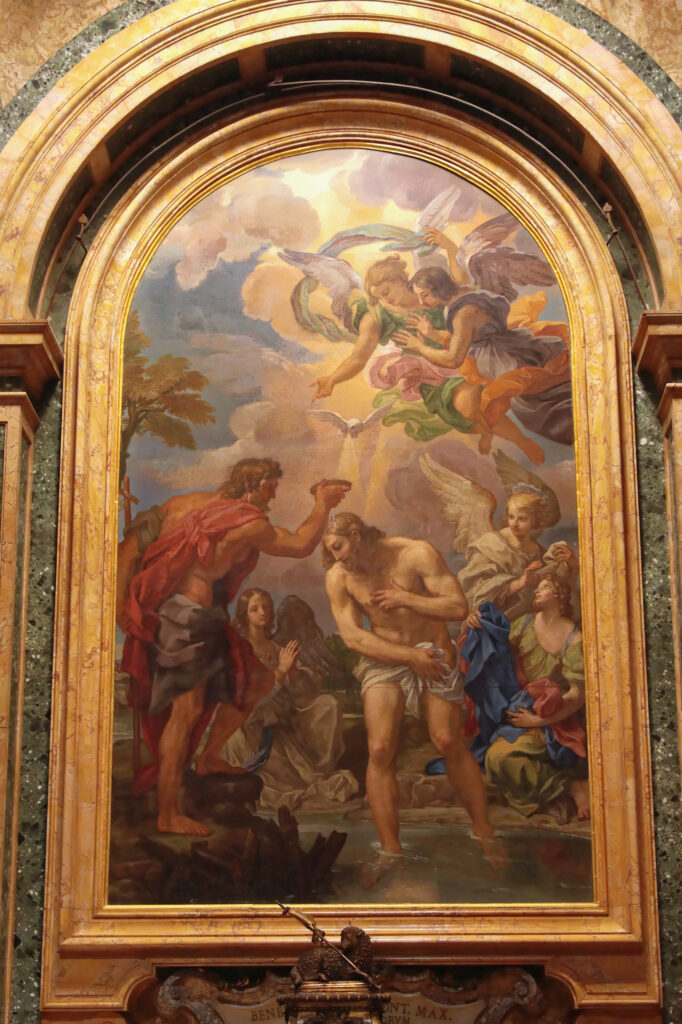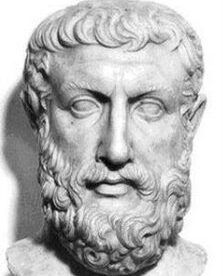
The Baptism of Jesus by John the Baptist by Gemälde von Seitenaltar, St. Peter’s Basilica
Available at Thriftbooks, Abebooks, and Amazon
Book Length: 276 pages
In the Gospel, Our Lord told us that the truth makes us free (cf. John 8:32). One of the greatest barriers to the conversion of modern man which His enemies have set up over the past hundred years is an entirely false narrative about the totality of history. The narrative is essentially that man’s creation was an accident, and that men were in the darkness until the “modern age”. They started, as we are told, in the cave—similar to the Platonic allegory. Though contrary to it, men were stuck in that cave for thousands, no millions of years, until…well, that question is still up for debate among the proponents of this worldview. One can imagine all the men which the secular humanists have canonized in a cramped room, each proudly asserting that it was their revolution which brought mankind “enlightenment”:
“It was 1517!” says Luther.
“No, it was 1632!” cries Galileo.
“Move over,” the chorus of the Continental Congress protests, “it was 1776!”
“Quiet you simpletons,” Churchill, sounding like a fiddle, interjects: “It was 1945!”
Then a final voice, that of John XXIII, booms louder than the others:
“I am afraid they have gotten it all wrong; it was 1960, the year of the New Pentecost!”
In any case, it is this very narrative which G.K. Chesterton boldly confronted in this nearly one hundred year old book. The text is divided into two parts: the first is about man, and the second is about the God-Man, Jesus Christ. In this first part, he attacks the commonly held notions about the “cave-man” and other such Darwinian fantasies assumed a priori in a lucid and straightforward manner. His thought process forces even one who is familiar on the subject of Creationism and knows the standard arguments to reach numerous eureka moments. He writes something plainly such as this, here describing the folly of those who have pretended to reconstruct the primordial days of man:1
They have described scenes that are wholly imaginary, in which the men of the Stone Age are men of stone like walking statues; in which the Assyrians or Egyptians are as stiff or as painted as their most archaic art. But none of these makers of imaginary scenes have tried to imagine what it must have been like to see those things as fresh which we see as familiar. They have not seen a man discovering fire like a child discovering fireworks. They have not seen a man playing with the wonderful invention called the wheel, like a boy playing at putting up a wireless station. They have never put the spirit of youth into their descriptions of the youth of the world.
(66)
Thus the secular iconographers fail to capture the true spirit of their subjects, while the Christian iconographer does. An artist of this sort can visit Lascaux, but they cannot visit Heaven. Why then is it easier for the believer in the Nicene Creed to replicate the beauty of Heaven here on earth than for the believer in the millions of years myth to replicate the existence of “primitive” man? Because the art that follows from that Creed is, as Dante would put it, the grandchild of God. It requires the submission of the imagination to Him who forged that very imagination in His own image and likeness (cf. Genesis 1:26). On the other hand, the secular iconographer’s art is inspired solely by myths which are the work of human hands.
Chesterton proceeds from his evaluation of the “cave-man” to his evaluation of the first civilizations (post-diluvian ones, that is). As in the preceding chapters, he tears apart the widely-held assumptions about that era of history in a superb manner, and this is followed up by a point ultimately more important than the last; how the cults which came before and after compare to the Church of Christ.
The author creates categories for these divisions of “natural religion” which, as he argues convincingly, are far from the “geographical and vertical” classifications the reader will be familiar with. His system is based instead on psychological and horizontal factors (from the closest to Divine Revelation to the furthest) which take into account “the strata of spiritual elements and influences that could sometimes exist in the same country, or even in the same man” (87).
These classifications are:
– God
– The Gods
– The Demons
– The Philosophers
And indeed, it is his explanation of these categories which takes up many of the pages of this book. The distinctions between each are masterfully drawn, and though he seems not to leave a stone unturned in the most critical matters of proving the superiority of this system, he does leave the reader with plenty to think about.
For instance, he makes the brilliant observation that:
Polytheism…was never to the pagan what the Catholicism is to the Catholic. It was never a view of the universe satisfying all sides of life; a complete and complex truth with something to say about everything.
(124)
For all the prattling about of the neopagans, their post-Christianity is what sets them the furthest apart from their ancestors. The pagans of antiquity never conceived of their beliefs forming some kind of absolute and universal belief system. In fact, the idea of an absolute belief system is a plagiarism from the Christian faith. As Chesterton put it, the schools of the Greek philosophers and the cults of Olympus never had “any collision in which one really destroyed the other” and that “there was never any combination in which one was really reconciled with the other” (126). Moreover, one can look at the example of the Pantheon in Rome for further proof of this. If paganism was an absolute belief system, then why did the followers of Cybele, Apollo, and innumerable other cults mutually accept the existence of the divinities of the others?
Contrast then this spirit to that which was born of the Spirit of Truth:
The Christian creed is above all the philosophy of shapes and the enemy of shapelessness.
(215)
It is this kind of contrast, hinted at earlier in the text, which continues this profound journey of historical reflection into the study of the age of the Incarnation. Christ “humbled himself” first by taking on His humanity, without which we would not have gotten Calvary (Philippians 2:8). Chesterton, as all believing Catholics, posit this sobering yet liberating truth as the center of history.
And in comparing Christ to the other men who are claimed to be founders of great religions allegedly equal to that of the Catholic Faith, Chesterton delivers a strong retort. In his paradoxically lucid fashion, he illustrates that in comparing these men to Christ, we see how utterly unique He stands apart and above them all. When we read through the Gospels and learn therein the life of Christ, Chesterton comments that:
We are meant to feel that Death was the bride of Christ as Poverty was the bride of St. Francis. We are meant to feel that his life was in that sense a sort of love-affair with death, a romance in pursuit of the ultimate sacrifice.
(207)
It is this “sort of love-affair with death” that culminates in the Resurrection. The world hated Him before us; yet, “the servant is not greater than his master” (John 15:20). Thus our Faith has and will continue to be attacked. But we need not fear. One of Chesterton’s most famous quotes, drawn from this very book, provides a great and relieving clarity for us in these trying times:
Christianity has died many times and risen again; for it had a God who knew the way out of the grave.
(250)
This is perhaps the most critical lesson of true history; all the errors past and present, from Gnosticism to Modernism, have been conceived by Satan to destroy or distort this truth. “And if Christ be not risen again, then is our preaching vain, and your faith is also vain” (1 Corinthians 15:14). As the Church has given witness to the veracity of the Scriptures, so too has history given witness to the Church. The Church has come quite close to dying in a human sense on five different occasions according to the author, yet it overcame what would have destroyed it if really were a mere philosophy or cult made by men. Following his argument, we may very well say that the Faith has been going through a sixth death, that brought on by the synthesis of all heresies: Modernism.
Just as how it survived “the most savage and most universal persecutions from the shock of the Diocletian fury to the shock of the French Revolution” and “has survived its own weakness and even its own surrender” it will survive the present crisis (259). By understanding a truthful telling of history, we not only better grasp the present but also the future. With this in mind, we can ascertain that as in the case of those other “five deaths” men and women will need to not just pray, but to do good works so that we may fully cooperate with God’s Will in overcoming the darkness that faces us. What that looks like is different for each of us; St. Monica was not asked to boldly confront the errors of her day as her son did. But it was her prayers, her good works, and her example which played an instrumental role in the conversion of that son, who was spiritually raised from the grave of a sinful life to become the illustrious St. Augustine.
Therefore, Chesterton’s sound (and occasionally quite humorous) presentation of history comes as a great source of edification to the modern reader. It may even be said that this book is needed now more than in his time, as the errors he discussed and dissected all those years ago have only gotten more perniciously widespread. Thus in its pages, Catholics will recognize a familiar voice, despite the separation of nearly one hundred years which stands between modern readers and the author. Even persons who have learned much of the true history of the world would benefit immeasurably from reading this fantastic book. And to those who are looking for an introduction to the vast corpus of Chesterton’s works, this is a great place to start.
